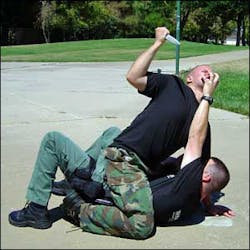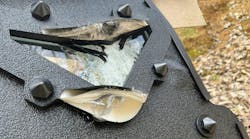Most of us recognize that defeating an assailant armed with an edged weapon would be no easy task. However, some police officers assume (remember assume makes an "ass" out of "u" and "me") that they will be able to control the situation with their firearm. I'm sure you've heard the maxim, "Don't bring a knife to a gunfight." Sounds like good advice. However, be mindful of the fact that without sufficient time and distance to perceive the threat, successfully deploying your firearm will be next to impossible.
The premise of this column is that you are taken to the ground by a knife-wielding suspect who's straddling you in what's commonly referred to as the "mount." The suspect will post one hand on the ground for balance and maximum leverage for stabbing. Using an "ice pick" grip (blade oriented downward), he will attempt to thrust the knife into your face, throat, or upper chest. If possible, the suspect will stab you multiple times, with potentially fatal consequences.
Anyone who's ever seen Surviving Edged Weapons by Calibre Press knows how difficult it can be for an officer to deal with a committed edged weapon attack while standing at a distance of 21 feet. So how can you expect to win from your back, with the suspect straddling you and preventing you from accessing your firearm? Consider the four-step sequence listed below.
The technique described will be in response to a right-handed attack.
- Step one: Strike under the chin/gouge the eyes
Even if you manage to grab the suspect's wrist with both hands in what many consider to be a secure grip, you could still be in serious trouble. First of all, since you're only controlling the wrist, the elbow and shoulder joints can move freely. This enables the suspect to maneuver the weapon out of your grasp. Secondly, while both of your hands are "busy" trying to control the knife-wielding arm, the suspect has a free hand to strike you with.
Regardless of what the suspect is doing with the knife, you've got to immediately seize the offense. This can be accomplished by thrusting your left palm under the suspect's chin and jamming your fingers into his eyes. This should accomplish several things, including inflicting pain, disrupting the suspect's vision, and most importantly, moving his head (and probably the knife) away from you.- Immediately after striking the suspect's eyes, thrust your right arm across your body underneath his left arm, which is posted on the ground. Your arm now momentarily shields your head and neck from attack. Drive your elbow back and down, striking the suspect just below the crook of his left arm with your triceps. This will cause the arm to flex, resulting in the suspect's weight shifting toward your right shoulder. The weight shift is critical in the successful execution of this technique.
- Simultaneously push the suspect's right upper arm with your left hand, thrust your hips upward and to the right, pushing off the ground with your left foot. Use your right hand to prevent the suspect from moving his right knee out to maintain his balance. These actions, when combined with the weight shift described above, should allow you to "sweep" the suspect onto his back. He will likely wrap his legs around your waist, in what's known as the "guard" position. At this point you have greatly improved your odds not only of surviving, but also winning the confrontation!
Deliver one or more palm strikes to the suspect's head, while maintaining constant pressure on the knife-wielding arm, pinning it to the ground. Remember that the impact of such blows will be greatly intensified, since his head will be braced against the ground. In this case, striking is a means to an end. Remaining in contact with a suspect armed with a knife is ill-advised. Your goal should be to achieve a standing position and to draw your firearm as soon as possible.
Ideally, you would then move to a position of cover and issue verbal commands to the suspect. However, if you can't break free from the suspect and he continues to fight while in possession of or in close proximity to the knife, the solution to your problem might be to deliver well placed rounds to stop the threat.
While I hope that none of us are ever lying on our backs, fighting a suspect armed with an edged weapon, I encourage you to prepare for the possibility of it happening. Find a partner and use an inert knife. Experiment to see if the technique presented here works well for you. If not, find one that does.
After training slowly to engrain proper technique, pick up the pace. While wearing appropriate headgear with eye protection and using a rubber knife, test various techniques at speed and see what holds up. Don't worry too much about the knife glancing across your hand or arm. Your goal should be to avoid being stabbed in a vital area and to achieve a dominant position.
Train hard and stay safe!



